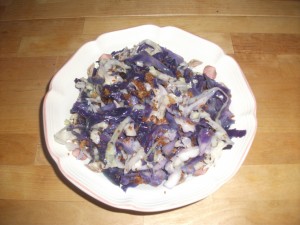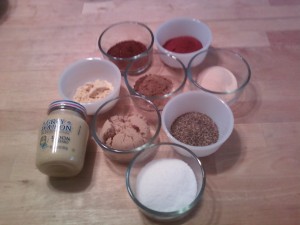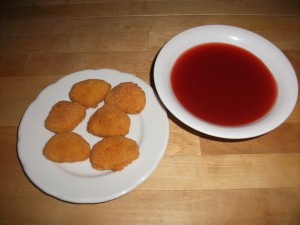In my previous article “So Many Baking Powders…“ I examined the differences between the many baking powders which are available in your local grocery store, to help provide you with a greater understanding of how they differ, and give you some guidelines to determine how one might be preferable over another for a particular baking application. I also challenged you, my reader, to experiment with the different baking powder formulations to determine which was best for your specific baking project.
As a follow up to that article, I conducted an experiment in the Lukewarm Legumes Test Kitchen of available formulations of baking powders using a basic recipe for making biscuits utilizing baking powder as a leavening agent. The Baking Powders tested were: Argo, Calumet, Clabber Girl, Rumford, and a Homemade formulation. These are all of the major baking powder formulations available to the general consumer in grocery stores nationwide. The formulation of the store brand baking powder offered by my local grocery matches that of Calumet, which my grocer does not carry, and for which I made a special trip to a local “Epicurean” market to obtain.

Methodology
In conducting a controlled experiment, the goal of the methodology used is to eliminate all variables except those which are the subject of the experiment.
This experiment was conducted according to the following process, and to the best of my knowledge eliminated all variables except that which came from the addition of baking powders with different formulas:
1. All biscuits were made using the same recipe. The recipe used to conduct this experiment was the one which is included below.*
2. All biscuits were prepared simultaneously, in the same kitchen, using (other than the baking powder formulations) the same ingredients (from the same batch package), baked in the same oven, at the same temperature, and at the same time.
3. All biscuits were formed with the same cutter to ensure they were of uniform size when going into the oven.
4. All baking powders came from new, unexpired and unopened containers.

Judging
Judging was performed by a panel of impartial individuals according to three categories of predetermined standards.
The predetermined standards used for judging the biscuits were as follows:
1. External Characteristics
a. Height
b. Weight
c. Spread
d. Crust
e. Color
2. Internal Characteristics
a. Color
b. Moisture
c. Fluffiness
d. Graininess
3. Flavor – level of pleasantness
A copy of the judging form used in this experiment can be downloaded here.

Judging was done by a panel of eight judges in the Lukewarm Legumes Test Kitchen and the biscuits were examined and tasted right after they came out of the oven; while they were still warm and fresh. Baking was done in three batches with separate formulations segregated and served in dishes marked numerically.
Judging results are as follows:
1. External Characteristics
a. Height – All biscuits before placing in the oven were 1/2 inch in height. The biscuit heights after baking were on average the following : Homemade 3/4″; ARGO 1″; Rumford 3/4; Clabber Girl 1″; and Calumet 1 1/4″.
b. Weight – Weight in proportion to size according to the judges were all average, or what was expected.
c. Spread – All biscuits started at 3″ diameter. The Homemade, Rumford, and Calumet shrunk to 2 1/2 or 3/4. The ARGO and Clabber Girl remained at 3″ diameter.
d. Crust – All biscuits had a balance between crustiness and softness, except the Rumford which was deemed below standard.
e. Color – All biscuits exhibited an external color which was to be expected.
2. Internal Characteristics
a. Color – All exhibited an internal color as was to be expected.
b. Moisture – All exhibited an internal moisture level as was to be expected.
c. Fluffiness – The Homemade Baking Powder ranked lower than the others for level of fluffiness.
d. Graininess – The Homemade Baking Powder ranked lower than the others for level of graininess.
3. Flavor – level of pleasantness
The judges by far preferred the flavor of the biscuits made with ARGO and Rumford. These are the formulations, other than the Homemade, which do not contain aluminum.
CONCLUSION
As was to be expected, the baking powders did not affect the characteristics of weight, moisture level, or appearance. These are the product of the other ingredients in the recipe. Also, the preparations other than the Homemade did not affect the texture (fluffiness or graininess) of the biscuits.
Where the different formulations did make a significant difference was in their leavening ability. Here, the ARGO and Clabber Girl were the superior performers. Also significant and unrelated to their ability to provide leavening, but important in their role as a biscuit ingredient, was flavor. Clearly, the aluminum free formulations (ARGO and Rumford) won out over the Clabber Girl, Calumet and Homemade in the flavor category. The judges felt overall the ARGO was the superior Baking Powder formulation in this test.
WINNER: ARGO
___________________________________________
RECIPE
*Baking Powder Biscuits
Ingredients
2 c Flour, All Purpose
1 T Baking Powder**
1 t Salt
1/3 c Shortening, Vegetable
1 c Milk
Instructions
In a medium mixing bowl, stir together flour, baking powder and salt. Using a pastry blender, cut in shortening till mixture resembles coarse crumbs. Make a well in center; add milk all at once. Using a fork, stir just till moistened.
On a lightly floured surface, knead dough just until the dough is nearly smooth.
Pat or lightly roll dough to 1/2-inch thickness. Cut dough with a 3 inch biscuit cutter, dipping the cutter into flour between cuts.
Place biscuits on an ungreased baking sheet. Bake in a 450° oven for 10 to 12 minutes or until golden. Serve warm.
___________________________________________
**Baking Powders used and their formulations:
Argo – Sodium Acid Pyrophosphate, Sodium Bicarbonate, Corn Starch and Monocalcium Phosphate
Calumet – Baking Soda, Cornstarch, Sodium Aluminum Sulfate, Calcium Sulfate and Monocalcium Phosphate
Clabber Girl – Cornstarch, Sodium Bicarbonate, Sodium Aluminum Sulfate and Monocalcium Phosphate
Rumford – Monocalcium Phosphate, Sodium Bicarbonate and Cornstarch
Homemade – 2 parts Cream of Tarter [Potassium Bitartrate] to 1 part Baking Soda [Sodium Bicarbonate] mixture









Follow Us!